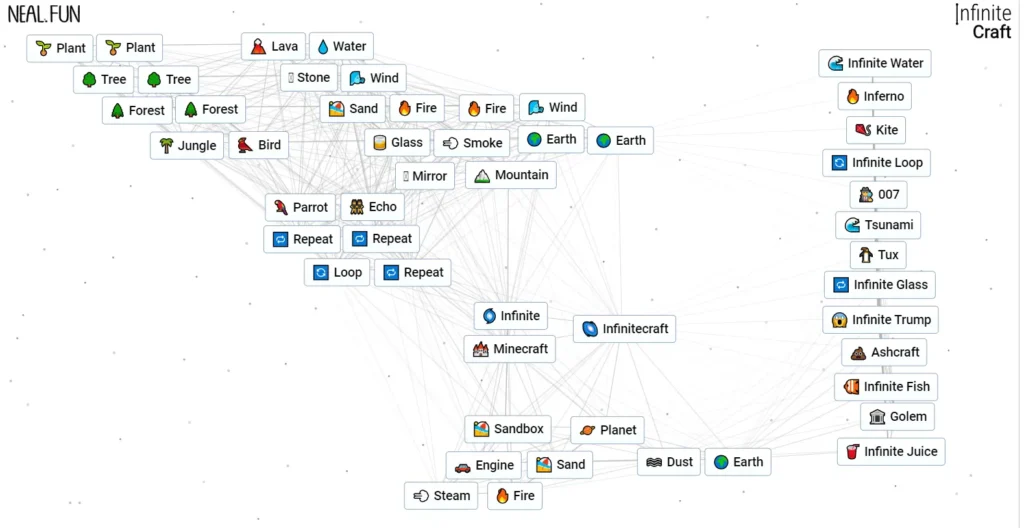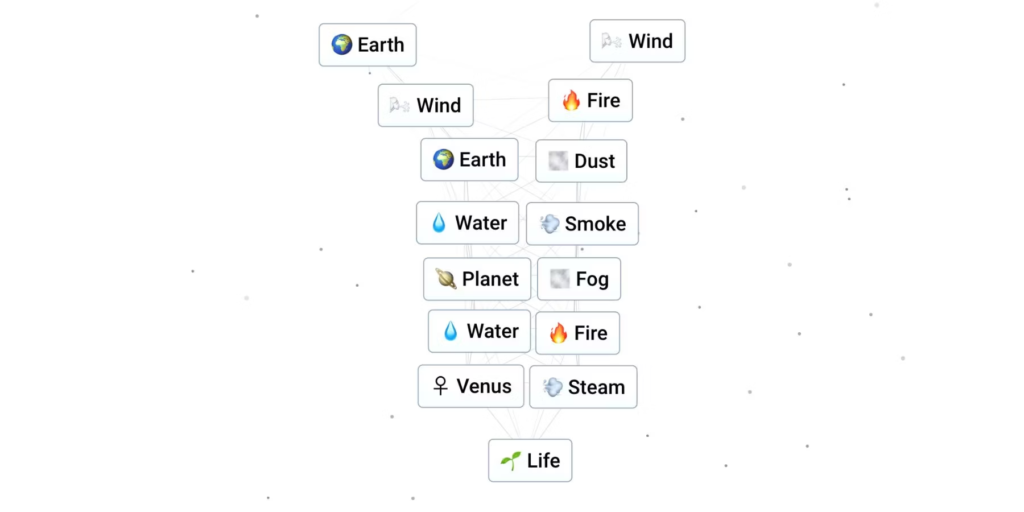
infinite craft recipes
infinite craft recipes Crafting has always been about pushing boundaries, mixing creativity with functionality, and bringing ideas to life through various materials. But what if those boundaries could be eliminated? What if, instead of a limited set of recipes, you could access an endless array of crafting possibilities? Welcome to the fascinating concept of infinite craft recipes. Whether you’re a seasoned crafter or someone just stepping into the world of creation, this concept opens up a world of endless potential and innovation.
In this article, we’ll dive deep into the concept of infinite craft recipes, how it is changing the way we approach crafting in different mediums, and what it means for the future of creative industries. We’ll explore the technological advancements that make this idea possible, its implications on gaming, real-world applications, and much more.
1. Understanding Infinite Craft Recipes

At its core, crafting is about taking resources and transforming them into something new—whether that’s a physical object or a digital creation. Traditionally, crafting is limited by a set number of recipes, predetermined by the designer or developer. These recipes dictate what materials you can combine, and what the result will be. The idea of “infinite craft recipes” flips this model on its head by allowing for virtually unlimited combinations and results.
The Concept Behind Infinite Craft Recipes
The term infinite craft recipes sounds almost like an oxymoron at first. After all, how can something be infinite? The key is in the flexibility of the crafting system. Rather than relying on static, pre-set combinations, infinite crafting relies on dynamic algorithms, procedural generation, or user-driven input to create recipes on the fly. This can be seen in certain types of games where you can mix items to create something unique, and the possibilities are only limited by your imagination and the available materials.
For example, in certain sandbox games, players can experiment with combining different materials or elements in the game, and the system will generate new items or outcomes based on that. There is no limit to what can be created because the recipes aren’t static—they evolve based on the player’s interactions.
How Does It Work?
Several technical approaches can be applied to make infinite craft recipes a reality. One of the most common techniques involves procedural generation. This method uses algorithms to create random or semi-random outputs based on certain rules. In crafting, this could mean that certain materials always interact in specific ways, but the result can vary widely depending on various factors such as quantities, conditions, or even the player’s inputs.
Another approach is modular crafting. This method involves breaking down items into smaller components that can be combined in a variety of ways to create new items. For example, if you’re crafting a sword, the blade, handle, and guard could all be customizable. Each component would have its properties, and the final product would reflect a combination of those properties.
The Role of AI in Infinite Craft Recipes
Artificial intelligence (AI) is becoming increasingly important in creating and managing infinite crafting systems. AI algorithms can analyze vast amounts of data to understand how different materials interact, predict what kind of outcomes players might be looking for, and even learn from user behavior to improve the crafting experience over time.
Imagine a system where the AI learns from your crafting preferences and starts suggesting recipes based on your previous creations. This not only enhances the creative process but also keeps things fresh and exciting by constantly evolving with the user’s input.
2. Infinite Craft Recipes in Gaming: A Game-Changer
Crafting in video games has always been a significant feature, particularly in genres like sandbox games, survival games, and RPGs (Role-Playing Games). Games like Minecraft, Terraria, and No Man’s Sky have popularized the concept of crafting in open worlds where players can create tools, weapons, and even entire structures. But even in these expansive games, crafting is still somewhat limited by predefined recipes.
How Infinite Crafting Could Revolutionize Gaming
Imagine a game where you are not limited by a set number of crafting recipes. Instead, you could combine any number of materials and receive a truly unique item each time. This would add a whole new layer of depth to the gaming experience, making every player’s journey different from the next. The possibilities for exploration, experimentation, and creativity would be endless.
Infinite crafting could turn gaming into a more personalized experience. No longer would players simply follow a guide or a tutorial to create the “best” item. Instead, they would need to experiment, test, and discover what works best for their playstyle. This kind of crafting would encourage a higher level of engagement and replayability, as players would always have something new to discover.
Procedural Generation in Games
Procedural generation is already widely used in gaming to create environments, enemies, and quests. With infinite crafting, this same technology could be applied to items and tools. For example, in a survival game, you could mix different materials like wood, metal, and stone to craft a unique weapon. The game’s algorithm would then determine the stats, appearance, and effectiveness of the weapon based on the properties of the materials used.
This could lead to some exciting discoveries. Maybe you’ll craft a weapon that is incredibly strong but fragile, or one that is weak but highly durable. The thrill of discovery would become a key part of the crafting process.
Customization and Personalization
Another exciting aspect of infinite craft recipes in gaming is the ability to fully customize and personalize your creations. If crafting is no longer limited by predefined recipes, players could create items that are truly one-of-a-kind. This could extend to everything from the appearance of the item to its functionality.
This level of personalization could also lead to more meaningful experiences. In games that focus on multiplayer, for example, players could trade or sell their unique creations, giving rise to in-game economies based entirely on user-generated content.
3. The Impact of Infinite Craft Recipes on the Crafting Community
The crafting community has long thrived on creativity, resourcefulness, and a passion for making things. From knitting and woodworking to 3D printing and digital crafting, the possibilities are nearly endless already. However, with the introduction of infinite craft recipes, the community could see a dramatic shift in how projects are approached and executed.
Breaking Free from Traditional Boundaries
One of the most significant impacts of infinite craft recipes is the removal of traditional boundaries. In the crafting world, recipes have often acted as both a guide and a limitation. While they provide structure, they can also stifle creativity by dictating exactly how something should be made. With infinite craft recipes, these limitations disappear, opening the door for more spontaneous, experimental crafting.
For example, imagine a 3D printer that allows you to input any combination of materials and patterns and generates a unique object based on those inputs. The result would be an endless array of possible creations, limited only by your imagination.
A Collaborative Future
The idea of infinite craft recipes also lends itself well to collaboration within the crafting community. When recipes are no longer static, crafters can share their own unique creations, inspire others, and even build upon each other’s ideas. This could lead to the development of entirely new crafting techniques and methods that wouldn’t have been possible in a more rigid system.
Online crafting forums and social media groups could become hubs of innovation, where users exchange ideas, challenge each other to create new combinations, and celebrate the diversity of creations that arise from infinite crafting systems.
Redefining Mastery in Crafting
In the traditional sense, mastering a craft often means perfecting a set of techniques or learning specific recipes to create the highest quality work. But what does mastery look like in a world of infinite craft recipes? In this new paradigm, mastery may be more about understanding the underlying principles of materials and their interactions, rather than memorizing a finite number of recipes.
This shift could also lead to new forms of recognition within the crafting community. Instead of being known for a particular technique or recipe, crafters may gain recognition for their ability to create unique, innovative combinations, or for their ability to push the boundaries of what is possible within the infinite crafting system.
4. Real-World Applications of Infinite Craft Recipes
While the concept of infinite craft recipes is largely associated with digital realms like gaming, the implications for real-world crafting are equally exciting. Imagine applying this idea to industries like fashion, architecture, or even food. The potential for innovation is vast.
Fashion and Textiles
In the world of fashion, designers are always looking for new ways to push the envelope. The idea of infinite craft recipes could revolutionize the way clothing and accessories are created. Instead of working with a limited set of patterns and materials, designers could mix and match fabrics, colors, and textures to create entirely unique pieces. This could be particularly valuable in sustainable fashion, where repurposing and upcycling materials are key.
For example, a designer could input a range of recycled fabrics into a system that uses algorithms to generate new patterns and combinations. The result could be one-of-a-kind garments that are not only eco-friendly but also visually stunning.
Architecture and Construction
The construction industry could also benefit from the concept of infinite craft recipes, particularly in the field of architecture. By combining different building materials and design elements, architects could create structures that are truly unique and tailored to specific needs or environments. This could be particularly valuable in creating sustainable buildings that use locally sourced materials and innovative construction methods.
For example, an architect could design a building that incorporates both modern materials like steel and glass, along with traditional materials like wood or stone. The system would generate a design that maximizes the strengths of each material, creating a structure that is both aesthetically pleasing and highly functional.
Culinary Arts
In the culinary world, chefs are always experimenting with new ingredients and flavor combinations. Infinite craft recipes could take this experimentation to a whole new level. Imagine a system that allows chefs to input a list of ingredients and generates unique recipes based on those inputs. The result could be entirely new dishes that have never been tasted before.
This could be particularly useful in the world of molecular gastronomy, where chefs use science and technology to create innovative dishes. By applying the principles of infinite craft recipes, chefs could push the boundaries of what is possible in the kitchen, creating dishes that are not only delicious but also visually stunning and intellectually stimulating.
5. The Future of Infinite Craft Recipes
As we look to the future, it’s clear that the concept of infinite craft recipes has the potential to transform a wide range of industries. Whether it’s in gaming, fashion, architecture, or the culinary arts, the possibilities are truly endless. However, there are also challenges to consider, particularly when it comes to balancing creativity with functionality and practicality.
Ethical Considerations
One of the challenges of infinite craft recipes is ensuring that the system is used responsibly. In industries like fashion and architecture, for example, it’s important to ensure that the materials being used are sustainable and ethically sourced. Infinite crafting systems should be designed with these considerations in mind, promoting responsible consumption and production.
Balancing Creativity with Usability
While the idea of infinite crafting is exciting, it’s also important to consider the practical implications. In gaming, for example, players may enjoy experimenting with new combinations, but they also need to ensure that the items they create are useful and functional. Striking the right balance between creativity and usability will be key to the success of infinite crafting systems.
The Role of AI and Machine Learning
As AI and machine learning continue to evolve, they will play an increasingly important role in the development of infinite crafting systems. These technologies have the potential to not only enhance the crafting experience but also make it more personalized and intuitive. By analyzing user behavior and preferences, AI can help generate crafting recipes that are tailored to individual tastes and needs.
6. Conclusion: The Infinite Possibilities of Crafting
The concept of infinite craft recipes represents a paradigm shift in the way we approach crafting, both in digital and real-world applications. By breaking free from the limitations of static recipes, we open up a world of endless possibilities, where creativity knows no bounds. Whether it’s in gaming, fashion, architecture, or any other field, the potential for innovation is immense.
As technology continues to evolve, we can expect to see infinite crafting systems become more sophisticated, intuitive, and widely adopted. For crafters, designers, and creators of all kinds, this represents an exciting opportunity to push the boundaries of what is possible and unleash their full creative potential.
In the end, the future of crafting lies not in memorizing recipes, but in exploring the infinite combinations that can be created when creativity meets technology. The world of infinite craft recipes is one of endless discovery, where the only limit is your imagination.





